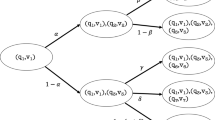Abstract
For infinite machines that are free from the classical Thomson’s lamp paradox, we show that they are not free from its inverted-in-time version. We provide a program for infinite machines and an infinite mechanism that demonstrate this paradox. While their finite analogs work predictably, the program and the infinite mechanism demonstrate an undefined behavior. As in the case of infinite Davies machines (Davies in Br J Philos Sci 52(4):671–682, 2001), our examples are free from infinite masses, infinite velocities, infinite forces, etc. Only infinite divisibility of space and time is assumed. Thus, the infinite devices considered are possible in a Newtonian Universe and they do not conflict with Newtonian mechanics. Note that the classical Thomson’s lamp paradox leads to infinite velocities which may not be producible in acceptable models of Newtonian mechanics. Finally, it is shown that the “paradox of predictability” is similar to the inverted Thomson’s lamp paradox.




Similar content being viewed by others
References
Adamatzky, A. A. (2019). A brief history of liquid computers. Philosophical Transactions of the Royal Society B,. https://doi.org/10.1098/rstb.2018.0372.
Boolos, G. S., Burgess, J. P., & Jeffrey, R. C. (2007). Computability and logic (5th ed.). Cambridge: Cambridge University Press.
Burgin, M. (2003). Nonlinear phenomena in spaces of algorithms. International Journal of Computer Mathematics, 80(12), 1449–1476.
Burgin, M., & Klinger, A. (2004). Three aspects of super-recursive algorithms and hypercomputation or finding black swans. Theoretical Computer Science, 317(1–3), 1–11.
Clark, P., & Read, S. (1984). Hypertasks. Synthese, 61(3), 387–390.
Copeland, B. J. (2002). Hypercomputation. Minds and Machines, 12(4), 461–502.
Cotogno, P. (2009). A brief critique of pure hypercomputation. Minds and Machines, 19, 391–405.
da Costa, N. C. A., & Doria, F. A. (2009). How to build a hypercomputer. Applied Mathematics and Computation, 215(4), 1361–1367.
Davies, E. B. (2001). Building infinite machines. British Journal for the Philosophy of Science, 52(4), 671–682.
Earman, J., & Norton, J. D. (1996). Infinite pains. The trouble with supertasks. In A. Morton & S. P. Stich (Eds.), Benacerraf and his critics (pp. 231–261). Hoboken, NJ: Wiley-Blackwell.
Falkovich, G., & Sreenivasan, K. R. (2006). Lessons from hydrodynamic turbulence. Physics Today, 59(4), 43–49.
Hagar, A., & Korolev, A. (2006). Quantum hypercomputability? Minds and Machines, 16(1), 87–93.
Hogarth, M. (1996). Predictability, computability, and spacetime. PhD thesis, Sidney Sussex College, Cambridge.
Meneveau, C., & Sreenivasan, K. R. (1991). The multifractal nature of turbulent energy dissipation. Journal of Fluid Mechanics, 224, 429–484.
Minsky, M. L. (1967). Computation: Finite and infinite machines. Upper Saddle River, NJ: Prentice-Hall Inc.
Nayebi, A. (2014). Practical intractability: A critique of the hypercomputation movement. Minds and Machines, 24(3), 275–305.
Németi, I., & Dávid, G. (2006). Relativistic computers and the turing barrier. Applied Mathematics and Computation, 178(1), 118–142.
Rummens, S., & Cuypers, S. E. (2010). Determinism and the paradox of predictability. Erkenntnis, 72(2), 233–249.
Sreenivasan, K. R., & Meneveau, C. (1986). The fractal facets of turbulence. Journal of Fluid Mechanics, 173, 357–386.
Stannett, M. (2012). Computing the appearance of physical reality. Applied Mathematics and Computation, 219(1), 54–62.
Syropoulos, A. (2008). Hypercomputation: Computing beyond the Church–Turing barrier. New York: Springer.
Thomson, J. (1954). Tasks and supertasks. Analysis, 15(1), 1–13.
Wüthrich, C. (2015). A quantum-information-theoretic complement to a general-relativistic implementation of a beyond-Turing computer. Synthese, 192(7), 1989–2008.
Acknowledgements
This work is supported by the Russian Science Foundation (RSF) Project 18-11-00032. This paper is also a contribution to the project M3 of the Collaborative Research Centre TRR 181 “Energy Transfer in Atmosphere and Ocean” funded by the Deutsche Forschungsgemeinschaft (DFG, German Research Foundation) under Project Number 274762653. I would like to thank Prof. Dr. Marcel Oliver (Jacobs University), Dr. Ryan North (Hamburg University), the editors of Erkenntnis, and anonymous reviewers, for their valuable comments and very useful discussions.
Author information
Authors and Affiliations
Corresponding author
Additional information
Publisher's Note
Springer Nature remains neutral with regard to jurisdictional claims in published maps and institutional affiliations.
Rights and permissions
About this article
Cite this article
Kutsenko, A.A. Programming Infinite Machines. Erkenn 87, 181–189 (2022). https://doi.org/10.1007/s10670-019-00190-7
Received:
Accepted:
Published:
Issue Date:
DOI: https://doi.org/10.1007/s10670-019-00190-7




